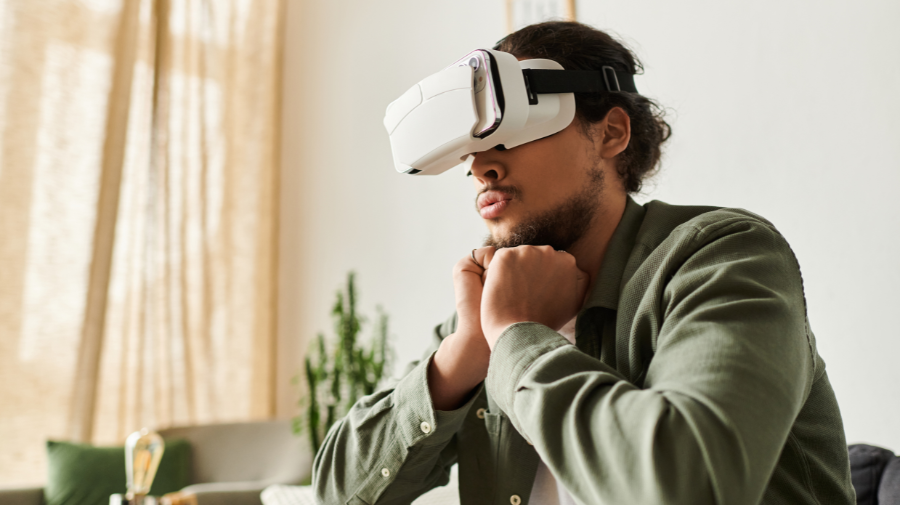Could VR become another tool in the therapy toolkit?

You’ve probably heard the buzz about virtual reality. It’s not just for video games anymore. More and more, therapists across the country are using VR to help their clients in new and powerful ways. If you’ve been curious about what this technology can do for your practice, you’re in the right place.
This post will walk you through how therapists use VR today. We’ll look at what it is, how it works in a therapy setting, why it’s gaining traction, and what you need to consider before jumping in. Let’s explore how this tool could fit into your work.
How VR works in therapy
Virtual reality uses a headset to place a person inside a computer-generated, 3D environment. The key to its power is a feeling called “presence“, which the brain’s sense of actually being in that virtual place. For therapy, this means you can create controlled, repeatable, and safe scenarios that are difficult or impossible to replicate in an office.
Therapists use VR in several key ways.
Immersive exposure therapy is one of the most common uses. You can gradually expose a client to a feared stimulus in a controlled way. For a client with a fear of heights, you can have them walk across a virtual bridge. For a veteran with PTSD, you can recreate a convoy scene. You control the intensity, allowing for safe and structured exposure.
VR can also be a safe space to practice real-world skills. Clients with social anxiety can practice making eye contact with avatars or navigate a virtual party. The environment is judgment-free, which helps build confidence before they try these skills in the real world.
Some therapists use VR to assist in relaxation and mindfulness. Imagine guiding your client through meditation on a peaceful virtual beach or in a quiet forest. VR can block out external distractions and create a deeply immersive setting for relaxation, mindfulness, and breathing exercises.
For clients with chronic pain, VR can act as a powerful distraction. Engaging the brain with compelling visual and auditory information can reduce the perception of pain. This is becoming a popular non-pharmacological tool for pain management.
The evidence: Does VR therapy actually work?
The research is promising and growing. Studies show that VR-assisted therapy can be very effective, especially for specific conditions.
For PTSD, controlled trials have shown that VR exposure therapy can have a significant impact on symptoms when compared to control groups. However, a meta-analysis pointed out that an individual’s ability to become immersed could heavily influence the effectiveness of that type of therapy, so more studies are needed.
For phobias and anxiety, VR has proven just as effective as in-person exposure therapy for fears of flying, heights, and spiders. It’s also becoming more common to help clients get over a fear of public speaking. A major benefit is that clients are often more willing to try it, with lower dropout rates than traditional exposure methods.
The use of VR is also expanding into areas like depression, where apps guide users through behavioral activation, and psychosis, where clients can interact with avatars representing their auditory hallucinations. Daniel Freedman, PhD, discusses how VR can be used to help treat paranoia. While the data is still emerging in these areas, the initial results are positive.
There are also ways to use VR to build skills for clients with autism or developmental disabilities. The clients are placed in simulated job interviews or conversations where they can practice building skills to help them navigate neurotypical society.
Why are more therapists adopting VR?
The shift toward VR isn’t just about cool technology. Several practical factors are making it more accessible and attractive for clinical practice.
First, it’s more affordable. High-quality, standalone VR headsets now cost less than $500. You no longer need a powerful computer or complex setup. The hardware is becoming as common as a tablet or laptop.
Billing is becoming clearer. In 2023, the American Medical Association (AMA) introduced a new CPT add-on code (0770T) for using VR to assist therapy. While Medicare coverage is still inconsistent, many major commercial insurance providers like UnitedHealthcare, Cigna, and Aetna have started to cover it. This legitimizes its use and creates a path for reimbursement.
Telehealth paved the way. The pandemic made therapists and clients comfortable with remote care. This has reduced the psychological barrier to trying new technologies like VR, which can be used both in-office and remotely.
There’s also the rise of “geek therapy” where video games are used to help clients with their mental health. It’s no longer a fringe idea. While some therapists may balk at the idea of playing video games with clients, it’s a great way to build rapport, practice skills, and create virtual safe spaces where clients can express themselves.
What are the challenges and risks of using VR in therapy?
Of course, integrating any new tool into your practice comes with challenges. It’s important to be aware of the potential downsides.
Some users experience nausea or dizziness (called cybersickness), similar to motion sickness. This affects about 7-14% of people, but modern headsets with high refresh rates have reduced this issue. It’s important to start with short sessions and monitor your clients.
Not everyone has access to the high-speed internet needed for remote VR therapy. There’s a risk of widening the gap for clients in rural areas or from lower socioeconomic backgrounds, especially if insurance coverage remains inconsistent.
And while VR headsets have gotten cheaper, not every therapist has a few hundred dollars lying around for spending on experimental technology. In a field that’s known to be underpaid, a VR headset can feel like a luxury.
VR headsets can collect a lot of data, including eye movements and micro-gestures. This raises important questions about HIPAA compliance and how this sensitive data is stored and protected. You must ensure any platform you use is secure and compliant.
Adopting VR means learning a new system, managing hardware, and handling technical troubleshooting. As this APA article points out, you can’t just put a headset on someone without doing exercises to prepare them. This can add uncompensated time to your day, so it’s important to factor that into your implementation plan.
And while there are starting to be more VR programs designed for mental health, Kim Bullock, founder and director of Stanford’s Neurobehavioral Clinic and Virtual Reality & Immersive Technology Clinic and Laboratory, points out that there are very few systems set up for therapists, considerably limiting scenarios.
How to get started with VR in your practice
Virtual reality has moved from a research novelty to a practical clinical tool with demonstrated benefits. For conditions like PTSD, anxiety, and phobias, it offers a powerful and effective treatment modality. For therapists, it provides a new way to engage clients, control therapeutic environments, and even expand your practice.
If you are considering it, start small. Research different VR therapy platforms, check with the insurance payers you work with about reimbursement for code 0770T, and try a headset yourself (you don’t want to spend the money only to find out you get sick when wearing it yourself). By understanding both the potential and the pitfalls, you can make an informed decision about whether VR is the right next step for you and your clients.
Want to bring your practice into the future? Try TheraNest! From AI tools to automated billing, we make your EHR easy and work for you. Start your free 21-day trial today, no credit card needed.






